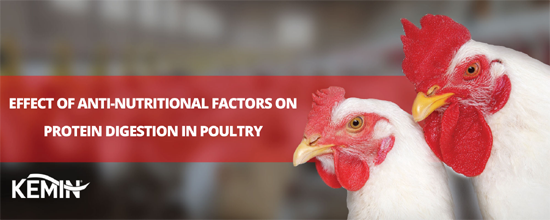Protein is the major and most expensive nutrient in all the poultry diets and the protein quality determines the flock performance to a large extent. Nutritional quality of a protein ingredient is directly related to amino acid bioavailability. This is because the bird doesn’t have a requirement of protein per se but requires readily available amino acids from the protein source.

Various animal and plant ingredients are the main sources of protein used in poultry diets and varies in digestibility and amino acid composition. The notion of protein nutrition is based on the sequential process through which proteins are digested and the amino acids are absorbed and become available for metabolic processes. Quality of a protein source can be influenced by a number of factors of which some are related to protein source itself like anti-nutritional factors, while others are related to various manufacturing processes that are used to develop particular protein meal.
Anti-nutritional factors (ANF) or agents can broadly be defined as secondary plant metabolites and structural compounds which interfere with the normal metabolic activities/ processes of the animal when present in the feed ingredients. In some cases, these compounds provide structural support, whereas, some metabolites have evolved as a mode of defense mechanism to protect the plant from insect damage. Some anti-nutritional factors represent important storage minerals and intermediate molecules used in various pathways by the plants.
Important anti nutritional agents that can seriously impact the quality of a protein source and subsequent digestibility are as depicted under.
• PHENOLIC COMPOUNDS
Tannins are a group of water-soluble polyphenolic compounds which may be found in some protein meals of plant origin. They are normally present in legume seeds, cereal grains and oil seeds. Tannins are classified into hydrolysable and condensed tannins. Hydrolysable tannins may have esters of gallic, m-digallic or hexahydroxy diphenic acids, which are easily hydrolyzed. Condensed tannins are resistant to hydrolysis and are polymers of flavan-2, 4-diol and flavan-3-ol or a mixture of both. Tannins cause precipitation of protein out of solution through the formation of soluble and insoluble complexes and are known to reduce the digestibility of amino acids in poultry. Tannins inhibit the absorption of protein from the digestive tract. Low molecular weight tannins may be absorbed from the intestine and cause toxicity through the inhibition of key metabolic pathways. Another class of polyphenolic compounds called sinapines are found in many plant feed ingredients and are choline esters derived from 3, 5-dimethoxy-4-hydroxyinnamic acid or tannins. During oxidation, phenolic acids may react with proteins to form indigestible complexes like quinines, which bind to the functional group of lysine and methionine. Tannins have been reported to potentially cause protein precipitation, which can lead to depression in protein and amino acid digestibility in animals that are fed tannin-containing cereals and legumes. It is believed that under optimal conditions, sorghum tannin is capable of binding and precipitating at least 12 times its own weight of protein. Gossypol is a polyphenolic compound occurring naturally in the seeds, foliage and roots of most cotton plants. It is a natural defence compound produced by the plants against pests and diseases. Gossypol can be found in free or in bound (attached to a protein) forms with the bound form being less toxic than the free form. The bound form is considered less toxic as it may diminish the quality of proteins causing negative effects on growth.
• GLUCOSINOLATES
Glucosinolates are the secondary defense metabolites present in some plants that are used to protect from animals and microorganisms. All plants in the Brassica family contains some level of glucosinolates. The glucosinolates are converted by myrosinase hydrolysis into unstable compounds, which are further converted to thiocyanates, nitriles and isothiocyanates. Rapeseed meal with high levels of glucosinolates is known to increase the incidence of hemorrhagic liver in broilers, resulting in reduced feed intake and weight gain. Myrosinase is the key enzyme involved in the conversion of glucosinolates to its toxic products and can be inactivated by heating during meal processing. Presence of these glucosinolates coupled with other anti-nutritional factors can have a serious reduction in feed intake and crude protein digestibility.
• PROTEASE INHIBITORS
Most of the plant-based protein sources that are used in the animal feed production contains some type of protease inhibitor. Typically, these are the compounds which inhibit the activity of various proteases such as trypsin, chymotrypsin, carboxypeptidases, elastase, and α-amylase. Protease inhibitors block the activity of trypsin, chymotrypsin, elastase, and carboxypeptidase. Soybean is considered to have the highest trypsin inhibitor activity among all the plant protein sources used in poultry. Inhibitors bind to the active site of enzyme, thereby reducing their ability to lower the kinetic energy needed during the proteolytic cleavage. Trypsin inhibitors can be inactivated to a large extent, but not completely by heat processing including extrusion, infrared radiation, micronizing, boiling, autoclaving, steam processing or flaking, or they can be removed by fractionation. The extent of heat inactivation of trypsin inhibitors depends upon several factors including the initial endogenous level, temperature, heating time, particle size, moisture, and perhaps crop species and cultivar. Feeding of raw soyabean protein preparations or inhibitors removed from soyabeans caused an increased size of the pancreas in susceptible animals. Exposure to soyabean trypsin inhibitors resulted in an increased synthesis and secretion of proteases (such as trypsin, chymotrypsin and elastase) and pancreatic hypertrophy and hyperplasia in animal models. Depression in the animal growth by trypsin inhibitors is related to an increased loss of endogenous amino acids in the form of enzymes that are secreted by increasingly active and hypertrophic pancreas. Since trypsin and chymotrypsin are mainly rich in sulphur-containing amino acids, a hyperactive pancreas would lead to diversion of these amino acids from the synthesis of body tissue proteins to the synthesis of enzymes, which are subsequently lost in the feces. Various workers have reported the negative impact of trypsin inhibitors and other antinutritional factors from soyabeans, kidney beans, etc. not only on protein and amino acid digestibility, but also on protein quality and animal performance.
• PHYTATE
Animal feed ingredients of plant origin contain some level of phosphorus stored as phytic acid or phytate, which are known as myo-inositol hexaphosphoric acid and myo-inositol hexaphosphate, respectively. Since phytate is mostly found in the seeds of plants, it makes animal feed formulated with oil seeds and cereal grains as a source of phytate. Phytate having predominant negatively charged phosphate groups is best known to chelate several nutritionally essential nutrients in the gastrointestinal tract of humans and animals, making them less bioavailable. Ability of chelation by phytate results in its complex formation with nutrients such as proteins and minerals, which leads to reduced bioavailability of both the proteins and minerals. Phytate present in plants can have detrimental effect on the activity of digestive enzymes such as carboxypeptidases and aminopeptidases, which can be explained by the chelation of mineral cofactors or interaction with protein in the form of enzymes or substrates. Phytate may also bind with protein to form complexes in acidic and neutral pH conditions, which may inhibit the activities of digestive enzymes. Phytic acid has been reported to interfere with the proteolytic action of pepsin in several vegetable and animal proteins as determined in vitro, possibly through the formation of phytate: protein interaction complexes at low pH. Poultry doesn’t have the ability to use all the phosphorous bound by phytate, because inherent endogenous phytase (phytate degrading enzyme) is limiting. To overcome these negative effects of phytate, poultry industry has incorporated exogenous phytase in poultry diets. The exogenous phytase hydrolyzes ester bond between the inositol ring and phosphate group, thereby releasing phosphorus. An increase in the protein and amino acid digestibility has been reported with exogenous dietary phytase supplementation.
SUMMARY
Anti-nutritional factors have a great tendency to affect normal protein metabolism in animals. Therefore, usage of various cereals, legumes and oilseed cakes in poultry diets must be carefully evaluated before their usage in final feed. Use of exogenous enzymes like proteases and phytases must be considered while using feed ingredients containing various anti-nutritional factors. Also, usage level of such ingredients must be carefully scrutinized so as to prevent their negative impact on animal performance and ultimate profitability. As mentioned above, some anti-nutritional factors like trypsin inhibitors and phytate can be substantially reduced by the use of exogenous enzymes. In that context, Kemins’ solutions, namely, KEMZYME® Protease and Phygest™ HT can be used as an effective tool to minimize the effect of these anti-nutritional factors. KEMZYME® Protease is a combination of acid, alkaline and neutral proteases, which can significantly reduce the negative effects of trypsin inhibitors and improve protein digestion. Phygest™ HT is a tailored blend of E. coli phytase, which effectively degrades the phytate associated with various ingredients, thus preventing the low absorption and utilization of critical nutrients like amino acids, minerals, etc.
Source: Kemin Industries South Asia






